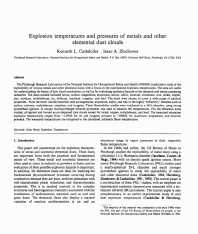Mining Publication: Explosion Temperatures and Pressures of Metals and Other Elemental Dust Clouds
Original creation date: July 2007
The Pittsburgh Research Laboratory of NIOSH conducted a study of the explosibility of various metals and other elemental dusts, with a focus on the experimental explosion temperatures. The data are useful for understanding the basics of dust cloud combustion, as well as for evaluating explosion hazards in the minerals and metals processing industries. The dusts studied included boron, carbon, magnesium, aluminum, silicon, sulfur, titanium, chromium, iron, nickel, copper, zinc, niobium, molybdenum, tin, hafnium, tantalum, tungsten, and lead. The dusts were chosen to cover a wide range of physical properties - from the more volatile materials such as magnesium, aluminum, sulfur, and zinc to the highly "refractory" elements such as carbon, niobium, molybdenum, tantalum, and tungsten. These flammability studies were conducted in a 20-L chamber, using strong pyrotechnic ignitors. A unique multiwavelength infrared pyrometer was used to measure the temperatures. For the elemental dusts studied, all ignited and burned as air-dispersed dust clouds except for nickel, copper, molybdenum, and lead. The measured maximum explosion temperatures ranged from approximately 1550 K for tin and tungsten powders to approximately 2800 K for aluminum, magnesium, and titanium powders. The measured temperatures are compared to the calculated, adiabatic flame temperatures.
Authors: KL Cashdollar, IA Zlochower
Peer Reviewed Journal Article - July 2007
NIOSHTIC2 Number: 20032563
J Loss Prev Process Ind 2007 Jul/Nov; 20(4-6):337-348
See Also
- The Critical Ventilation Velocity in Tunnel Fires - A Computer Simulation
- Determining the Root Causes of Flame Cutting and Welding Fires in Underground U.S. Coal Mines
- Evaluation of the Bagged Stone Dust Barrier Effectiveness in a Bord and Pillar Mine
- Experimental Mine and Laboratory Dust Explosion Research at NIOSH
- Initial Study of Buried Communication Cable for Underground Mines
- Rapid (Grab) Sampling During Full-scale Explosions - Microscopic and Analytical Evaluation
- Refuge Chamber Expectations Training - 1.0
- A Review of Recent Accidents Involving Explosives Transport
- The Role of ASTM E27 Methods in Hazard Assessment: Part II - Flammability and Ignitability
- U.S. Bureau of Mines Technology Applicable to Disaster Response, Urban Search And Rescue
- Content source: National Institute for Occupational Safety and Health, Mining Program


 ShareCompartir
ShareCompartir
